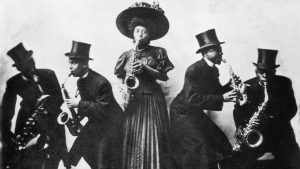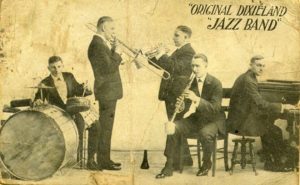Jass? Jasz? JAZZ!
From the red light district to the Grammophone: 100 years ago, the legendary black music from New Orleans came to her name and was forbidden for the first time on shellac – by a white band.

A Monday in Manhattan, February 26, 1917. It is winter, the last before the US enters the First World War. Three weeks before, the German Emperor Wilhelm II called the “unrestricted submarine war” and thus also targeted the American maritime trade; world-wide, one looks tense at the Europe war center. The five men who enter a house on 38th Street on this day seem to be completely unimpressed. History, however, they will also write.
The Victor Talking Machine Company, one of the great players in the recording industry, has set up a recording studio on the 38th street, a room with a piano and a meter-sized metal funnel, which converts the vibration of sounds into the movement of a needle Pattern in a uniformly rotating wax plate. The five men are musicians: trumpet, clarinet and trombone, drums, one sits down at the piano. Together they are the original Dixieland Jassband (ODJB).
They carefully try out the way they have to distribute themselves in the room, so that they can be heard in what the needle carves into the wax. At that time, the technique of sound recording was not yet developed. Thomas Edison had already patented a recording process with wax rolls as early as 1878, and the Jewish US immigrant Emile Berliner from Hannover developed ten years later an apparatus with a rotating wax plate – the forerunner of the gramophone. After editing, delete or single tracks and digits, but you can not yet. Any noise, rattling or squealing, coughing or throat cleans the whole thing. So the musicians have to play their pieces again and again, so long until finally there is a flashy recording of each one.

Exchange S against Z: A historical postcard shows the original Dixieland Jass band after their renaming. © Wikimedia Commons
Two pieces will be recorded on this February 26th: the Livery Stable Blues, a Foxtrott, then the original Dixieland Jass Band One Step. And even if the clarinetist Wilbur Steadman from Chicago, two months previously, with his DownHome Rag has presented a recording that could claim the rank of a very first jass record with some philological effort, it is the five by the ODJB, which the jazz as a new genre that is distinguished from ragtime and blues.
Even before them, musicians had used the four-letter word, a conceptual bastard with red-light connotations, the etymology of which is probably never elucidated. Sometimes it was jass or jasz, now, in the spring of 1917, the spelling jazz goes through quickly. And just as 20 years ago, the automated piano and the offset offset printing have driven the rise of the ragtime, just as ten years later the radio will blow the wind into the wings, so it is now the record that popularizes jazz power. It catapults the music into the age of its technical reproducibility. It gives her a range that makes generic names such as “jazz” necessary. And it offers the possibility to practice this new, improvised art by repeated listening and imitating.
The musicians of the ODJB were not yet a band in their native New Orleans. They were regarded as solid, but by no means superior, instrumentalists. Three of them, the cornettist Nick LaRocca, trombonist Eddie Edwards and drummer Tony Sbarbaro, came from families of Sicilian immigrants, a population group that was far down in the social pyramid. Everyone, including pianist Henry Ragas and clarinetist Larry Shields, had played in one of the bands of the white percussionist Papa Jack Laine, a touchy musician with French roots, who since the beginning of the 1890s had moved next to a brass band, who rode the streets of New Orleans , led up to four other chapels for different social occasions. Ragtime and dance were the common denominator. No one from the band could claim one of the honorable titles given in the scene: Nick LaRocca was not a “king”, as the loudest and most exalted trumpeters were called. Henry Ragas was not a “professor”, none of those sovereign pianists who had played it all before.
In March 1916, LaRocca, Ragas, and Edwards led to Chicago, where musicians were in demand who could bring the New Orleans sound to the city. The response was overwhelming, the three founded their own band, the drummer Sbarbaro from New Orleans, and when the clarinetist Shields came out at the end of October 1916, the original Dixieland Jass band was complete.
A few months later, in January 1917, they made their first appearance in New York, at the newly opened Reiseweber’s Cafe at the distinguished Columbus Circle. Immediately the opinions about the band disagree. Some feel the new rhythms and dance styles as offensive, so the others are all the more enthusiastic. This music is not boring. The press reports, Mouthpropaganda provides for a rest, and a few days after the debut, the Victor Talking Machine Company invites the five musicians to record the studio.
From the Outset a Commercial Art Product
Two years before, Victor has tried to ban the new music from New Orleans on record. At that time, Freddie Keppard, a trumpet king from New Orleans, gave a guest performance in New York, declined the offer to enter the studio. Well, not a fortnight after the recordings, there is a shellac in the shops, in the middle the label with the famous Victorian Signet, among them the respective title, slightly smaller the name of the band, a serial number, 18255, the Note: For Dancing.
The recordings are very successful, according to circumstances. The instruments can be clearly distinguished, the trumpet’s leading role, the contrapuntal movement of the trombone, the harmonious ornamentation with which the clarinet fills the gaps, the bass riffs and chords of the piano, and the brachial accents of the drums. The band plays like under full steam, and because the tempo is very high – after all, the recording capacity is exhausted after a little more than three minutes – the virtuoso ornaments that form the nucleus for the solo improvisations that are in the streets of New Orleans the myth formation to particularly expressive musicians such as Buddy Bolden or later Louis Armstrong be fired. In their place, the Livery Stable Blues are performing animal voice imitations and other trumpet and trombone soundings.
The two songs are a hit – the sales figures are supposed to have left the million barrier quickly – and they define what is meant by jazz: movement and strange sounds. Afro-Caribbean rhythms are the result of marching music, European harmonica is associated with the unsteady tonality of the blues, pentatonic melodies can be heard, which may be from Ireland or Scotland as well as from West Africa, the hymnics of Protestant churches sound like the melting of Italian operas , the question-and-answer game of African choral songs, the then-first right of the Blues stands aside. It is a conglomerate that displays its connectivity for any further cultural influence.
In the port city of New Orleans, this music had developed in the decades before from the encounters of the most diverse population groups: New Orleans was a former French and Spanish colonial area, a gateway to the Caribbean in the heart of the US Southern states, marked by Catholic celebrations Louisiana Purchase in 1803 had become part of the orphanage US. At the center of the musical development were the experiences of the African population groups: on the one hand, the descendants of the slaves who had been abducted from Africa, few of whom had succeeded in social advancement, on the other hand the offspring of released blacks who had previously lived in some prosperity Reconstruction after the American Civil War had largely lost their privileged position as a part of the educated bourgeoisie.
Based on this prehistory, the music of the original Dixieland Jass Band is from the outset a commercial art product: its foundation was more due to chance and its success the result of some clever decisions.
The recording of the first jazz record in February 1917 coincided with a historical development which should shift the social fabric of the USA in the long term and also strongly shape the jazz itself. After the Civil War, a migratory movement from the agrarian South had been used in the industrialized cities of the North. Chicago, which had previously been one of the end stations of Underground Railroad, the network of supporters of escaped slaves, had a brilliant reputation among the African inhabitants of the Southern States. The slaughterhouses and the steel processing industry of the city produced a constantly growing demand for labor. The beginning of the First World War, which strangled the influx of immigrants from Europe, gave the Great Migration further impetus. In 1900, some 30,000 African Americans lived in Chicago, and in 1930 they were almost one million. The demand for the hot music, which the newly recruited workforce from the South knew. Contrary to frequent summons, the resolution of Storyville, the legendary amusement district of New Orleans, played only a subordinate role in the triumphant advance of jazz to the north, especially in November 1917, after the first recordings the ODJB.
Skin Color Far Less Decisive
The new medium record also catapulted the music into the industrial age. It made it possible to release music from the moment of the performance and to dispose of it at any time. Their popularity could be increased to unimaginable dimensions – at the expense of their rooted in a community.
In this way, two conflict lines were already laid down during the birth of jazz. On the one hand, the question as to the extent to which the mediated, jazz-jazz out of its origin can claim authenticity at all. From the beginning, musicians have pointed out this problem and expressed their discomfort in the genre designation “Jazz”: from Duke Ellington to Miles Davis and the musicians of the avant-garde cooperative AACM from Chicago to the young trumpeter Nicholas Payton, many African musicians reject the concept , He is for her a slang word full of sexual echoes, the whiteness of this music in a despicable purpose.
On the other hand, the ODJB is an early example of how white musician developments, which have been predominantly prompted by African musicians, have been successful again and again and have come into the spotlight instead of the actual creators of this music. On the other hand, the unanimity with which Louis Armstrong and Bix Beiderbecke, a dark-skinned and a white trumpet star of the genre, a few years later, confess their appreciation for the music of the original Dixieland Jass band and their clarinetist Larry Shields that the skin color in the founding phase of the jazz was far less decisive than it was later believed by many. To this day, the jazz can build on it.

